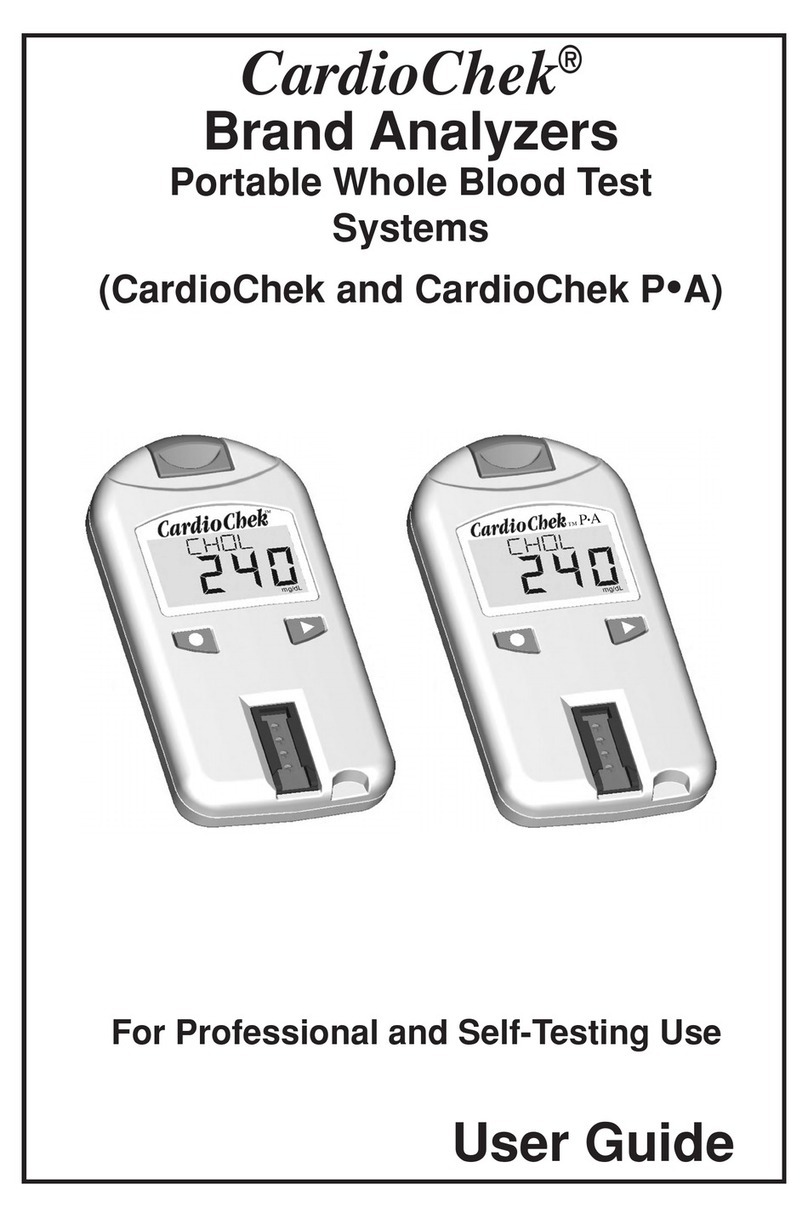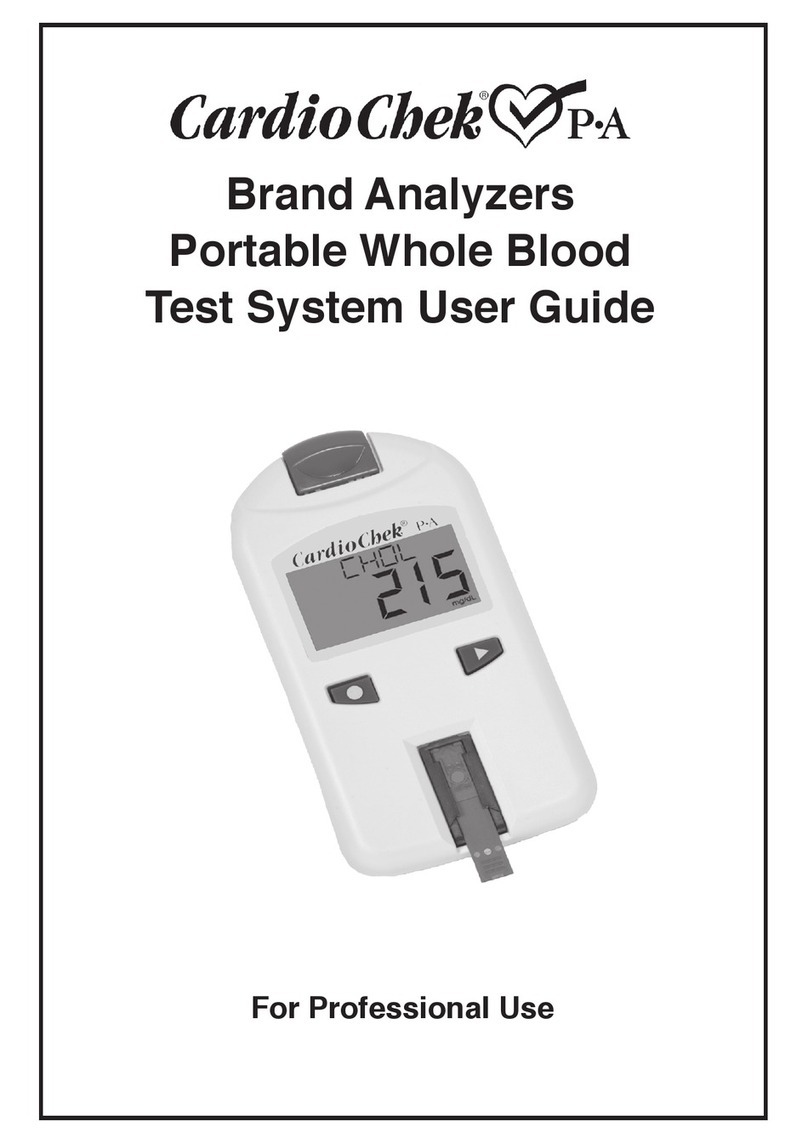Polymer Technology Systems CardioChek User manual

User Guide
CardioChekTM
Analyzer
Portable Whole Blood Test System
For Professional and Self-Testing Use


3
TABLE OF CONTENTS
The CardioChekTM Analyzer
I. Introduction......................................................................... 5
II. How to Use the User Guide ............................................... 6
III. Introduction to the CardioChek .......................................... 7
Analyzer - CardioChek Test System
MEMo Chip
Test Strip
IV. Set Up................................................................................. 10
Installing Batteries
Setting Language
Setting Time
Setting Date
Setting Units
Setting Sound
V. Checking the System .......................................................... 14
Check Strip
Quality Control
VI. Running a Test .................................................................... 16
Control Testing
Blood Testing
Testing Supplies
Quick Reference
VII. Memory .............................................................................. 22
Recalling Results
Clearing Memory
VIII. Care and Cleaning .............................................................. 23
Storage and Handling
IX. Troubleshooting ................................................................... 24
X. Specifications...................................................................... 26
XI. Contact Information............................................................ 27
Help
Catalog Numbers
XII. Warranty ............................................................................. 28
XIII. Explanation of Symbols ...................................................... 29
XIV. Index ........................................................................... 30


5
I. INTRODUCTION
Thank you for selecting the CardioChekTM Analyzer from Polymer
Technology Systems, Inc. (PTS).
The CardioChek is a fast, portable and accurate whole blood analyzer.
The CardioChek test system includes an analyzer and separately
available PTS PANELS test strips/MEMo Chip. This system is
intended for in vitro diagnostic use to test whole blood. Using this
system, you can quickly measure various blood components from a
small sample size. The CardioChek test system is capable of monitor-
ing for diabetes and other disease states and lipid screening.
The CardioChek uses reflectance photometry for testing. It reads color
changes that occur on a test strip after blood is placed on the test strip.
Before you begin testing, please read this entire User Guide and the test
strip package insert completely. This provides the necessary
information for the use of this system. Please remember to return the
enclosed warranty card to ensure you receive product updates.
Polymer Technology Systems, Inc.
Indianapolis, IN 46268 USA
(317) 870-5610
www.ptspanels.com
For questions or assistance with the CardioChek, call:
Customer Service:
1-877-870-5610 (toll free inside USA)
1-317-870-5610
Fax: 1-317-870-5608
E-mail: [email protected]

6
II. HOW TO USE THE USER GUIDE
This guide includes all the information you need to test properly
using the CardioChekTM Analyzer. For additional information and
specific information for each individual chemistry test, please make
sure you read the test strip package insert included with the test
strips. This guide is arranged in the order a new user would need
the information. Each section can be used separately, after you have
read the entire guide.
If you have questions about this system, please contact our Customer
Service department. Customer Service assistance is available during
the hours of 8:00AM- 5:00 PM Eastern Standard Time, Monday
through Friday. If you need help interpreting your test results, please
make sure that you contact your health care provider.
Customer Service:
Hours: 8:00 AM - 5:00 PM Eastern Standard Time
Monday - Friday
1-877-870-5610 (Toll-free inside USA)
1-317-870-5610
Fax: 1-317-870-5608
E-mail: [email protected]

7
III. INTRODUCTION TO THE
CARDIOCHEK ANALYZER
The CardioChek Test System:
The CardioChek test system consists of three main parts. These
include the analyzer, test strips and a MEMo Chip. When a blood
sample is applied to the test strip, a chemical reaction occurs producing
a color change. The analyzer measures the color reaction and com-
pares the information to the calibration curve stored in the MEMo
Chip. The analyzer converts this color reading into a test result, that
is displayed on the screen.
Display (a)
Display shows test results, messages, time, date, and stored results.
ENTER Button (b)
Press this button to turn the analyzer ON or to accept the current menu
choice.
NEXT Button (c)
Press this button to turn the analyzer ON or to advance to the next menu
option.
Test Strip Insert Opening (d)
The Test Strip Insert Opening is positioned in the lower front of the analyzer.
The strip is inserted here with the raised lines facing up.
MEMo Chip Port (e) For MEMo Chip and connectivity
The MEMo Chip Port is on the top of the analyzer. A lot specific MEMo
Chip is inserted into this port.

8
MEMo Chip (Top and Bottom)
MEMo Chip
The color-coded MEMo
Chip contains the settings for
each test.
The top of the MEMo Chip
has a finger notch. The
bottom has a label with the
test name and lot number.
The MEMo Chip
Each package of test strips contains a color-coded plastic chip with
a connector. This is called the MEMo Chip.
What does the MEMo Chip do?
When inserted with the finger notch facing up in your
CardioChek, the MEMo Chip does the following:
•Tells the analyzer which test(s) to run.
•Contains the calibration curve and the lot number code
for the specific test strip lot.
•Controls test sequences and timing.
•Establishes the measuring range for the test.
The MEMo Chip ensures you have the proper settings for the test strip
you are using.
Guidelines for using the MEMo Chip:
•The MEMo Chip must be in place to run a test.
•Use only the MEMo Chip that is included with each
package of strips. The lot number code on the test strip
vial, MEMo Chip, and analyzer display must match.
•If the expiration date in the MEMo Chip has expired, the
analyzer will display EXPIRED LOT.
•If your MEMo Chip is lost or missing, please call
Customer Service for a replacement.
III. INTRODUCTION TO THE
CARDIOCHEK ANALYZER
Top Bottom

9
III. INTRODUCTION TO THE
CARDIOCHEK ANALYZER
Inserting the MEMo Chip
into the MEMo Chip Port.
The MEMo Chip Port is on the top
center of the analyzer. The MEMo
Chip is inserted into this port with the
finger notch facing up. Push firmly, but
gently, until the MEMo Chip is fully
inserted. Be careful not to bend the
connector.
Test Strip
To test blood on the CardioChek , use test strips specific for each test.
The test strip is inserted into the analyzer, then blood is applied to the
test strip. A chemical reaction occurs producing a color change. The
analyzer measures the color reaction and compares the information to
the calibration curve stored in the MEMo Chip. The analyzer
converts this color reading into a test result, that is displayed on the
screen. Each test strip box contains a package insert that provides
instructions for use. The package insert provides information
specific for each test. Please read the instructions completely
before testing.
Using the MEMo Chip (continued):

10
The CardioChek requires two (2) AAA 1.5 volt alkaline batteries.
Battery Use and Replacement
When to Replace the Batteries:
The analyzer will give you an indication on the display that the batteries
need to be changed. When the display reads CHANGE BATTERY, no
more tests can be run until the batteries are changed. Always replace the
batteries with high quality alkaline batteries. It is recommended to keep a
spare set of batteries on hand. To extend battery life, remove the test strip
as soon as a result is displayed. The time/date and results stored in memory
will not be erased when the batteries are changed.
How to Turn theAnalyzer OFF:
The batteries will have a longer life due to the analyzer’s
automatic shut down feature. The analyzer will perform a 10 second
count down and turn OFF after three minutes of idle time (without a test
strip inserted). To stop shut down press either button ( or ). You
can turn the analyzer OFF manually by holding down both buttons
(and )at the same time for three seconds at any of the following
Main Menu headings: RUN TEST, MEMORY, UTILITY, and
USER SET. You can also remove the batteries to turn the analyzer
OFF.
IV. SET UP
WARNING! Dispose of the old batteries properly.
How to Install/Replace the Batteries:
1. Open the battery door on the back of the CardioChek by pressing
and sliding it in the direction of the arrow (toward the MEMo Chip
port).
2. Remove old batteries from the compartment and safely discard.
3. Insert the new batteries into the battery compartment with the
positive (+) terminal facing to the left on the top battery, and to the
right on the bottom battery as marked on the inside compartment.
4. Replace the battery door. To make sure the batteries were installed
correctly, push either one of the two buttons on the front of the
analyzer to turn the CardioChek ON.
Other manuals for CardioChek
1
Table of contents
Other Polymer Technology Systems Medical Equipment manuals



















